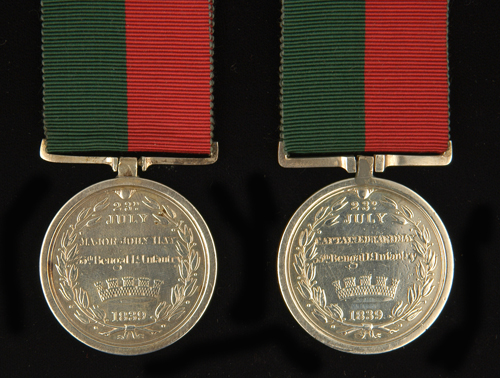
Auction: 7022 - Orders, Decorations, Medals & Militaria
Lot: 1332
The Rare, Historically Interesting, and Highly Emotive Pair of 1st Afghan War Medals For the Storming and Capture of Ghuznee to Major J. Hay, and His Brother Captain E. Hay, Both 35th Bengal Native Infantry; Major J. Hay Led a Gallant Diversionary Attack on the Fortress, and was Twice Mentioned in Despatches, But Died Later That Year; Captain E. Hay Was Killed In Action During the Retreat From Cabul When The Last Remnants of the Army Made Its Historic Final Stand at Gandamak, 13.1.1842- Their Bones Can Still Be Found To This Day on the Field of Afghanistan Ghuznee 1839 (Major John Hay 35th Bengal Lt. Infantry), reverse neatly engraved in upright serif capitals and lower case, very fine, with contemporary silver straight bar hinged suspension, with a superb quality miniature portrait on ivory of the recipient in full uniform, 115 mm x 95 mm, in original leather case Ghuznee 1839 (Captain Edward Hay 35th Bengal Lt. Infantry), named in the same style as above, minor edge bruising, very fine, with contemporary silver straight bar hinged suspension Estimate £ 3,000-3,500 Major John Hay (1802-39), born Aston, near Birmingham; educated at Shrewsbury School; commissioned Ensign 2/17th Native Infantry, 1819; Acting Adjutant 1822; Lieutenant 1823; transferred 35th Native Infantry, 1824; present at the siege and capture of Bhurtpoor, 1826 (would have been entitled to an Army of India with ´Bhurtpoor´ clasp had he survived); Captain 1829; Temporary Officer Commanding Calcutta Native Militia, 1831; attached to Staff of the Army of the Indus, 13.9.1838; served with the 35th N.I. during the 1st Afghan War, and led the diversionary attack on the Fortress of Ghuznee. Storming of Ghuznee On 23rd July 1839, the main attack on the fortress was to be led by Colonel Dennie against the Cabul Gate. In order to make his task possible a party of Engineers advanced in the early hours under the cover of darkness to lay charges against the gate. This operation did not go completely according to plan, however, as a sentry spotted one of the party and opened fire, thus alerting the garrison. The Officer Commanding Lieutenant-General Sir John Keene had allowed for this occurrence in his grand plan, and Hay with three Companies of the 35th N.I. were to create a diversionary attack to divert attention away from the Engineers, and ultimately Colonel Dennie: ´At the sound of the first shot from the battlements.... the skirmishers in the gardens engaged in a brisk fusillade. The rattle of Hay´s musketry was heard from the east. The garrison was alert in its reply. The northern ramparts became a sheet of flame, and everywhere the cannonade and musketry fire waxed in noise and volume´ (The Afghan Wars, A. Forbes, refers). Captain Hay´s diversionary attack was successful, the charges at the gate were blown, and Dennie´s men charged into the breach. The Garrison were completely taken by surprise, and after bloody hand to hand fighting the British forces carried the day. For his part in the capture, Hay was made Brevet Major and twice mentioned in Lieutenant General Sir John Keene´s despatch (London Gazette 30.10.1839), ´The Commander-in-Chief acknowledges the services rendered by Captain Hay of the 35th Native Infantry, in command of three companies of that regiment sent to the south side of the fortress to begin with a false attack and which was executed at the proper time and in a manner highly satisfactory to His Excellency´. Major John Hay died in Cabul, 13.10.1839, and was posthumously awarded the 3rd Class of the Order of the Dooranee (Calcutta Gazette 15.8.1840). Captain Edward Hay (1806-1842), born Aston, the younger brother of Major John Hay; commissioned Ensign 35th Native Infantry, 1827; Adjutant 8.10.1829-March 1841; served at Ghuznee 1839; Brevet Captain 8.8.1841, 35th Native Infantry, Shah´s service; Brigade Major 4th Brigade, 9.12.1840; appointed to Shah Shujah´s Army, 10.3.1841; Inspector 1st Regiment of Kazil Bush; Hay is mentioned several times in Lady Sale´s famous memoirs of the disastrous retreat of Elphinstone´s army from Cabul, in which she was taken prisoner, ´Capt. Hay was this day sent with a message of consequence to the King, attended by an escort of fifty horsemen. He went out of the cantonments at a brisk trot, and forded the river. The enemy kept an excellent look-out; they were immediately in pursuit, but our party got safe into the Bala Hissar. It was a beautiful sight to see Hay with his cap pulled down on his brows, his teeth set, neither looking right or left, but leading his men with the air of a man ready and expecting to encounter the worst and fully determined to do his devoir. We were all very anxious about him, and were delighted to hear that he had got back safe, for they were fired on in returning, and ten horses without riders were the heralds of their return´. On the 13th January 1842, the remnants of the army retreating from Cabul made its last stand under Major Griffiths at Gandamak, and it was here that Captain Edward Hay was killed in action- Surgeon William Brydon was the only survivor of the Army to ride into Jellalabad.
Sold for
£7,500




